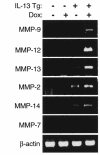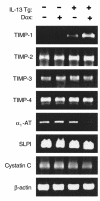Inducible targeting of IL-13 to the adult lung causes matrix metalloproteinase- and cathepsin-dependent emphysema
- PMID: 11067861
- PMCID: PMC301418
- DOI: 10.1172/JCI10458
Inducible targeting of IL-13 to the adult lung causes matrix metalloproteinase- and cathepsin-dependent emphysema
Abstract
Cigarette smoke exposure is the major cause of chronic obstructive pulmonary disease (COPD). However, only a minority of smokers develop significant COPD, and patients with asthma or asthma-like airway hyperresponsiveness or eosinophilia experience accelerated loss of lung function after cigarette smoke exposure. Pulmonary inflammation is a characteristic feature of lungs from patients with COPD. Surprisingly, the mediators of this inflammation and their contributions to the pathogenesis and varied natural history of COPD are not well defined. Here we show that IL-13, a critical cytokine in asthma, causes emphysema with enhanced lung volumes and compliance, mucus metaplasia, and inflammation, when inducibly overexpressed in the adult murine lung. MMP-2, -9, -12, -13, and -14 and cathepsins B, S, L, H, and K were induced by IL-13 in this setting. In addition, treatment with MMP or cysteine proteinase antagonists significantly decreased the emphysema and inflammation, but not the mucus in these animals. These studies demonstrate that IL-13 is a potent stimulator of MMP and cathepsin-based proteolytic pathways in the lung. They also demonstrate that IL-13 causes emphysema via a MMP- and cathepsin-dependent mechanism(s) and highlight common mechanisms that may underlie COPD and asthma.
Figures













Comment in
-
Animal models of emphysema: the next generations.J Clin Invest. 2000 Dec;106(12):1445-6. doi: 10.1172/JCI11791. J Clin Invest. 2000. PMID: 11120751 Free PMC article. No abstract available.
References
-
- Senior, R.M., and Shapiro, S.D. 1998. Chronic obstructive pulmonary disease: epidemiology, pathophysiology, and pathogenesis. In Fishman’s pulmonary diseases and disorders. Volume 1. A.P. Fishman et al., editors. McGraw-Hill Inc. New York, New York, USA. 659–681.
-
- O’Byrne PM, Postma DS. The many faces of airway inflammation: asthma and chronic obstructive pulmonary disease. Am J Respir Crit Care Med. 1999;159:S41–S66. - PubMed
-
- Rijcken B, et al. Long term variability of bronchial responsiveness to histamine in a random sample of adults. Am Rev Respir Dis. 1993;148:944–949. - PubMed
-
- Rijcken B, Schouten JP, Xu X, Rosner B, Weiss ST. Airway hyperresponsiveness to histamine associated with accelerated decline in FEV1. Am J Respir Crit Care Med. 1995;151:1377–1382. - PubMed
-
- O’Connor GT, Sparrow D, Weiss ST. A prospective longitudinal study of methacholine airway responsiveness as a predictor of pulmonary-function decline: the Normative Aging Study. Am J Respir Crit Care Med. 1995;152:87–92. - PubMed
Publication types
MeSH terms
Substances
Grants and funding
LinkOut - more resources
Full Text Sources
Other Literature Sources
Medical
Molecular Biology Databases
Miscellaneous

